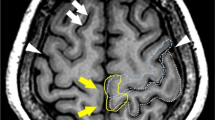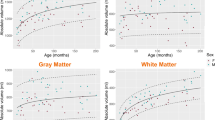Abstract
On T2-weighted MR images, the pontine tegmentum frequently shows a signal of high intensity in neurologically healthy individuals. We examined whether the signal intensity of the pontine tegmentum normally differs from that of the pontine base. We evaluated the signal intensity of the pontine tegmentum and pontine base on T2-weighted images from 38 neurologically healthy subjects. The subjects included 29 adults (16 males and 13 females, age range 23-48 years, mean age 39.5 years) and 9 children (4 boys and 5 girls (age range 4-9 years mean age 6.5 years). We compared the contrast-to-noise ratio (CNR) between the tegmentum and the base in the upper pons, midpons and lower pons, and evaluated the signal intensity ratio of the tegmentum to the base. The CNR was significantly higher for the tegmentum than the base at each level of the pons (P<0.0001), and the signal intensity ratio of the tegmentum to the base in the upper pons was significantly higher in children than in adults (P<0.005). On T2-weighted images, a high signal intensity of the pontine tegmentum is frequently seen in neurologically healthy subjects. This finding should not be considered abnormal, particularly in children.




Similar content being viewed by others
References
Vymazal J, Hajeck M, Patronas N, et al (1995) The quantitative relation between T1-weighted and T2-weighted MRI of normal gray matter and iron concentration. J Magn Reson Imaging 5:554–560
Hirai T, Korogi Y, Sakamoto Y, et al (1996) T2 shortening in motor cortex: effect of aging and cerebrovascular disease. Radiology 199:799–803
Korogi Y, Hirai T, Komohara Y, et al (1997) T2 shortening in the visual cortex: effect of aging and cerebrovascular disease. AJNR Am J Neuroradiol 18:711–714
Hirai T, Korogi Y, Yoshizumi K, et al (2000) Limbic lobe of the human brain: evaluation with turbo fluid-attenuated inversion-recovery MR imaging. Radiology 215:470–475
Georgiades CS, Itoh R, Golsy X, et al (2001) MR imaging of human brain at 1.5T: regional variations in transverse relaxation rates in the cerebral cortex. AJNR Am J Neuroradiol 22:1732–1737
Fatterpekar GM, Naidich TP, Delman BN, et al (2002) Cytoarchitecture of the human cerebral cortex: MR microscopy of excised specimens at 9.4 Tesla. AJNR Am J Neuroradiol 23:1313–1321
Chen JC, Hardy PA, Kucharczyk W, et al (1993) MR of human postmortem brain tissue: correlative study between T2 and assays of iron and ferritin in Parkinson and Huntington disease. AJNR Am J Neuroradiol 14:275–281
Whittall KP, MacKay AL, Graeb DA, et al (1997) In vivo measurement of T2 distribution and water contents in normal human brain. Magn Reson Med 37:34–43
Flannigan BD, Bradley WG, Maziotta JC, et al (1985) Magnetic resonance imaging of the brain stem: normal structures and basic functional anatomy. Radiology 154:375–383
Torack RM, Alcala H, Gado M, et al (1976) Correlative assay of computerized cranial tomography (CCT) water content and specific gravity in normal and pathological postmortem brain. J Neuropathol Exp Neurol 35:385–392
Brooks RA, Di Chiro G, Keller MR (1980) Explanation of cerebral white–gray contrast in computed tomography. J Comput Assist Tomogr 4:489–491
Takagi H, Shapiro K, Marmarou H, et al (1981) Microgravimetric analysis of human brain tissue: correlation with computerized tomography scanning. J Neurosurg 54:797–801
Hittmair K, Kramer J, Rand T, et al (1996) Infratentorial brain maturation: a comparison of MRI at 0.5 and 1.5 T. Neuroradiology 38:390–396
Novak P, Novac V, Kangarlu A, et al (2001) High resolution MRI of the brainstem at 8 T. J Comput Assist Tomogr 25(2):242–246
Miller AK, Alston RL, Corsellis JA (1980) Variation with age in the volumes of grey and white matter in the cerebral hemispheres of man: measurements with an image analyser. Neuropathol Appl Neurobiol 6:119–132
Barkovich AJ, Kjos BO, Jackson DE, et al (1998) Normal maturation of the neonatal and infant brain: MR imaging at 1.5 T. Radiology 166:173–180
Barkovich AJ (ed) (1990) Pediatric neuroimaging. Lippincott Williams & Wilkins, New York, pp 5–34
van der Knaap MS, Valk J, de Neeling N, et al (1991) Pattern recognition in MRI of white matter disorders in children and young adults. Neuroradiology 33:478–493
Martin E, Krassnitzer S, Kaelin P, et al (1991) MR imaging of the brainstem: normal postnatal development. Neuroradiology 33:391–395
Barkovich AJ (1998) MR of normal neonatal brain: assessment of deep structures. AJNR Am J Neuroradiol 19:1397–1403
Author information
Authors and Affiliations
Corresponding author
Rights and permissions
About this article
Cite this article
Asao, C., Hirai, T., Imuta, M. et al. Signal intensity of the normal pontine tegmentum on T2-weighted MR imaging. Neuroradiology 48, 166–170 (2006). https://doi.org/10.1007/s00234-005-0035-2
Received:
Accepted:
Published:
Issue Date:
DOI: https://doi.org/10.1007/s00234-005-0035-2




